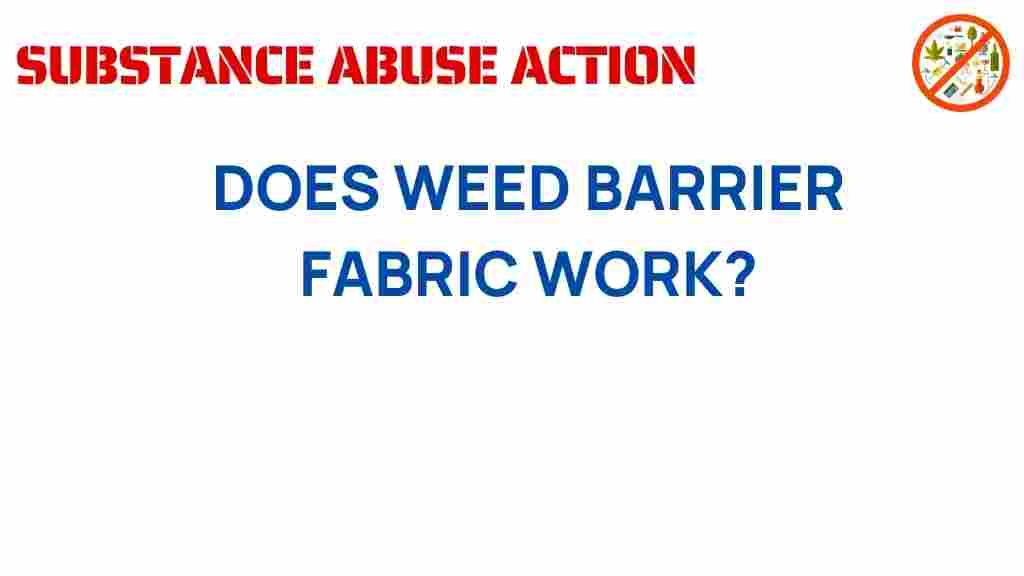Unraveling the Truth: Does Weed Barrier Fabric Really Work?
When it comes to gardening and landscaping, one of the biggest challenges faced by gardeners is weed growth. Weeds not only compete for nutrients and water but can also attract pests and diseases that may threaten your plants. This is where weed barrier fabric comes into play. But does it really work? In this article, we will explore the effectiveness of weed barriers, their impact on soil health, pest control, and how they can contribute to sustainable gardening practices.
What is Weed Barrier Fabric?
Weed barrier fabric, also known as landscape fabric or weed control fabric, is a material designed to prevent weed growth while allowing water, air, and nutrients to penetrate the soil. Typically made from synthetic fibers or natural materials, these fabrics are laid over the soil in gardens and landscaped areas to create a barrier against weeds.
How Does Weed Barrier Work?
The primary function of a weed barrier is to block sunlight from reaching the soil surface, which is essential for weed germination. By limiting light exposure, weed barriers can significantly reduce the number of weeds in a garden bed. Additionally, they can help maintain soil moisture and temperature, contributing to healthier plants.
Benefits of Using Weed Barrier in Gardening
Implementing a weed barrier can provide several benefits for gardeners and landscapers alike:
- Weed Prevention: The most apparent benefit is the reduction of weeds, leading to less competition for your plants.
- Soil Health: By blocking weeds, you maintain a healthier soil environment, allowing for better nutrient absorption.
- Pest Control: Some weed barriers can deter certain pests, reducing the likelihood of infestations.
- Garden Maintenance: With fewer weeds to manage, your garden maintenance routine becomes less labor-intensive.
- Eco-Friendly Options: Many weed barriers are now made from biodegradable materials, making them a sustainable choice for gardening.
Choosing the Right Weed Barrier Fabric
When selecting a weed barrier, it’s essential to consider the following factors:
- Material: Choose between synthetic fabrics, like polypropylene, or natural options, such as jute or coir.
- Thickness: Thicker fabrics tend to last longer but may be more expensive.
- Water Permeability: Ensure the fabric allows adequate water and air flow to the soil.
- Durability: Look for UV-resistant materials if you live in an area with strong sunlight.
Step-by-Step Guide to Installing Weed Barrier Fabric
To effectively use weed barrier fabric in your garden or landscape, follow this step-by-step guide:
Step 1: Prepare the Area
Clear the area of existing weeds, debris, and rocks. This may involve hand-pulling weeds or using a hoe. Ensuring the area is clean will improve the effectiveness of the weed barrier.
Step 2: Level the Soil
Rake the soil to create a smooth, level surface. This helps the barrier lay flat, reducing the chances of weeds growing up through gaps.
Step 3: Cut the Fabric to Size
Measure the area where you will be laying the weed barrier and cut the fabric accordingly, leaving some excess to overlap edges.
Step 4: Lay the Fabric
Place the fabric over the prepared soil, ensuring it is flat and covers the entire area. If necessary, use landscape pins or stakes to keep it in place.
Step 5: Secure the Edges
Overlap the edges of the fabric to prevent weeds from sneaking through. You can also bury the edges in soil for added security.
Step 6: Add Mulch
Top the weed barrier with a layer of mulch. This not only enhances the appearance of your landscape but also provides additional weed suppression and helps retain moisture.
Step 7: Monitor and Maintain
Regularly check your garden for any signs of weed growth. If weeds do appear, remove them promptly to prevent them from taking hold.
Troubleshooting Common Issues with Weed Barriers
While weed barriers can be highly effective, some issues may arise during their use. Here are common problems and their solutions:
Problem: Weeds Growing Through the Fabric
Solution: Ensure that the fabric is laid flat without gaps. If weeds still manage to grow through, consider using a thicker or denser fabric.
Problem: Soil Drying Out
Solution: If you notice the soil is drying out too quickly, ensure your weed barrier is adequately permeable. You may need to water your plants more frequently as the barrier may hinder natural moisture retention.
Problem: Fabric Degrading Too Quickly
Solution: Choose UV-resistant fabrics and check the material quality before purchase. If the fabric is degrading, it may be time to replace it.
Problem: Pests Under the Barrier
Solution: Some pests may find refuge under the fabric. Regularly inspect for signs of pest activity and consider integrating pest control measures such as beneficial insects or eco-friendly pesticides.
Eco-Friendly Alternatives to Weed Barriers
If you’re looking for sustainable gardening practices, consider these eco-friendly alternatives to traditional weed barriers:
- Organic Mulch: Using organic materials like straw, wood chips, or leaves can suppress weeds while enriching the soil as they decompose.
- Ground Covers: Planting ground cover plants can naturally suppress weeds while providing habitat for beneficial insects.
- Living Mulch: Certain crops, like clover, can be used as living mulch to prevent weed growth while improving soil health.
Conclusion
In conclusion, weed barrier fabric can be an effective tool for weed prevention in gardening and landscaping. By blocking sunlight, it helps maintain a clean and healthy garden environment. However, it’s crucial to choose the right fabric and install it properly to maximize its effectiveness. Additionally, by being mindful of soil health and pest control, you can create a thriving ecosystem in your garden.
Weed barriers, when used correctly, can significantly reduce garden maintenance efforts and contribute to sustainable gardening practices
This article is in the category Prevention and created by SubstanceAbuseAction Team
